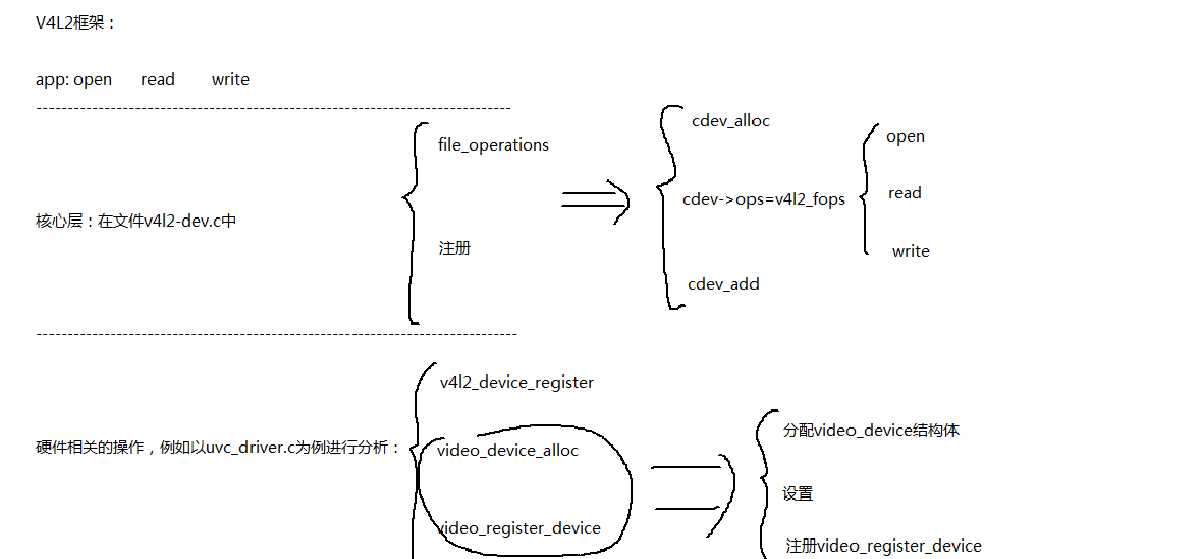标签:func 概念 相关 UNC pen reg sizeof ids static
V4L2驱动框架概述
V4L2(video for linux two)是linux为视频设备提供的一套标准接口。它也属于字符设备驱动程序。
首先回顾普通字符设备驱动程序的写法:
app : open read write
----------------------------------------------------------------------------
内核: drv_open drv_read drv_write
----------------------------------------------------------------------------
相关的硬件设备
1、如何写简单的字符设备驱动程序
(1)构造file_operations结构
.open =drv_open
.read =drv_read
.write =drv_write
(2)告诉内核
(3)入口函数
(4)出口函数
2、如何写复杂的字符设备驱动程序
以LCD驱动程序为例,进行简要说明。在LCD驱动程序里面引入了分层的概念,分为上下两层
(1)fbmem.c。注意这里面的内容内核已经帮我们做好了
构造file_operations结构体
.open/.read/.write
告诉内核
入口函数
出口函数
(2)硬件相关的内容,这部分内容需要我们自己来做
分配fb_info结构体
设置fb_info结构体
硬件相关的操作
注册
所谓注册,就是把fb_info结构体告诉fbmem.c。这样当应用程序调用open、read、write等函数来操作LCD时,首先会调用fbmem.c的file_operations结构体中的open、read、write等函数,进而调用fb_info结构体提供的open、read、write等函数。分层的好处在于:在写驱动程序的时候专注于硬件相关的那部分就可以了。其他通用的比如说fbmem.c中的内容,内核已经帮我们做好了。
前面已经说过,摄像头驱动程序也是一种字符设备驱动程序,它的结构框图如下:

当我们插入一个usb摄像头的时候,过程是怎样的?接下来简要分析一下:
在uvc_driver.c中
首先看一下入口函数:
static int __init uvc_init(void)
{
int ret;
ret = usb_register(&uvc_driver.driver);
}
struct uvc_driver uvc_driver = {
.driver = {
.name = "uvcvideo",
.probe = uvc_probe,//当它发现所能支持的设备时,就会调用该函数
.disconnect = uvc_disconnect,
.suspend = uvc_suspend,
.resume = uvc_resume,
.reset_resume = uvc_reset_resume,
/*假设我们接上了一个usb摄像头,这个摄像头在 uvc_ids里面,那么内核就会调用uvc_probe函数*/
.id_table = uvc_ids,
.supports_autosuspend = 1,
},
};
接下来再看一下uvc_probe这个函数:
/* -------------------------------------------------------------
* USB probe, disconnect, suspend and resume
*/
static int uvc_probe(struct usb_interface *intf,
const struct usb_device_id *id)
{
/*v4l2_device_register这个函数不重要,只是做了某些初始化的工作*/
if (v4l2_device_register(&intf->dev, &dev->vdev) < 0)
goto error;
/* Register video device nodes. */
if (uvc_register_chains(dev) < 0)
goto error;
}
接下来看一下函数uvc_register_chains做了什么事情?
static int uvc_register_chains(struct uvc_device *dev)
{
struct uvc_video_chain *chain;
int ret; list_for_each_entry(chain, &dev->chains, list) { ret = uvc_register_terms(dev, chain);
if (ret < 0)
return ret;
}
接下来分析uvc_register_terms:
/*
* Register all video devices in all chains.
*/
static int uvc_register_terms(struct uvc_device *dev,
struct uvc_video_chain *chain)
{
ret = uvc_register_video(dev, stream);
if (ret < 0)
return ret;
}
static int uvc_register_video(struct uvc_device *uvc)
{
struct usb_composite_dev *cdev = uvc->func.config->cdev;
struct video_device *video;
/* TODO reference counting. */
video = video_device_alloc();
if (video == NULL)
return -ENOMEM;
video->parent = &cdev->gadget->dev;
video->minor = -1;
video->fops = &uvc_v4l2_fops;
video->release = video_device_release;
strncpy(video->name, cdev->gadget->name, sizeof(video->name));
uvc->vdev = video;
video_set_drvdata(video, uvc);
return video_register_device(video, VFL_TYPE_GRABBER, -1);
}
通过简单的分析函数的调用过程,与上图我们猜测的过程刚好对应起来,本篇文章先让我们感性的来认识一下,摄像头驱动程序的框架。
标签:func 概念 相关 UNC pen reg sizeof ids static
原文地址:https://www.cnblogs.com/-glb/p/10292198.html